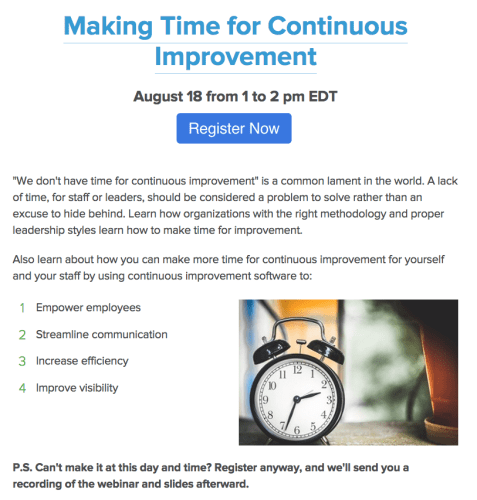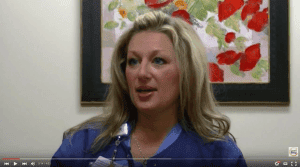It's been a little while, but here's a new video about Kaizen and continuous improvement from our friends at Franciscan St. Francis Health in Indianapolis.
See all of the videos in the link here or via my YouTube playlist.
In this video, Hollynn Lobsiger, the manager of the endoscopy unit, talks about what Kaizen means to her and her team and she also shares some thoughts about how to make time for Kaizen.
Everybody (or nearly everybody) complains about not having enough time for improvement – that includes time for staff and time for managers. The challenge is how to go from “lack of time” being an excuse to being a problem that you solve (see my video about this).
Hollynn and her team are a great example of being proactive to make time for improvement (as you can see in this video with staff describing an improvement). See how Hollynn sets a tone for them and expects input from everybody? They're “Kaizen Crazy!” :-)
How does Hollynn make time? How do they “fuel that fire” to go from “goose eggs” to many Kaizens?
Two things were key:
- Isolating time in staff meetings (time that was already dedicated)
- Doing Kaizen “blitzes” during an hour over lunch time
Note, she doesn't mean a “Kaizen Blitz” ala a “Kaizen Event” or a “Rapid Improvement Event” where you get a team together to solve one specific large problem. She means setting aside a period of time where they blitz or brainstorm or document a number of improvements.
How much time do they spend on Kaizen? They're “constantly thinking about it” (her staff say the same thing) and the time you put into it leads to time saved.
Here's a post from 2014 on this same topic, making time for Kaizen, that includes some thoughts from Jeff Liker, Michael Balle, Karen Martin, and others.
What can YOU do to create time for Kaizen? Please leave a comment on this post.
Listen to Mark read this post (learn more):
Upcoming Webinar on This Topic
“Making time for Kaizen” is the theme of an upcoming webinar that Greg Jacobson, MD and I are presenting next Tuesday, August 18 for KaiNexus. Learn more and register here.

Transcript of Hollynn's Video
Here is a transcript of the video:
My name is Hollynn Lobsiger. I'm the manager for endoscopy operations.
When I think about Kaizen, I think about trying to make changes in the workflow or something for patient care, just dependent on what your specific role is in the healthcare team.
I try to follow what I consider transformational leadership characteristics. I really try to get my staff engaged and involved in change. The reality is change is everywhere. That's a part of life. So, try to figure out either how to embrace it, be a part of it, make it better.
Where Kaizen comes into play is that mindset of you see a problem, identifying that it could be maybe done easier, faster, more efficiently. Even if it's something that's more satisfying, that's a kaizen. Try to take that mindset and just adapt it into everything from how my office is set up to my team and how they set their bedside carts up, to their office space, to their break room.
Really, I just challenge them to look at everything as a possibility to be changed. I think that helps your attitude accept it more. It fuels fire.
We do really well with competition, bragging rights, and things like that. It's kind of like fire, one starts going with the kaizen. Very rarely now do I have a single person on a kaizen. There are usually at least two people on a kaizen, so they work together.
But it's not always been like that. We've just really tried to move the culture to be one that we look for change, we look for things to be easier, we look for it to be more satisfying.
They know I have their back. If they bring something to me and they say, “We could do it this way,” there's always multiple ways to do something. If there are five ways to do something and their way that they presented is more efficient, safer, it's not a work-around, then it's a win for everybody.
We started out with goose egg numbers, is what we refer to them as several years ago. We didn't have any kaizens. We just tried to, as a group, educate ourselves and fuel that fire.
The two biggest bangs for the buck at the beginning for me was to isolate time during staff meetings. Meaning, time that they were already dedicating to meet. That way, it was a partnership between the two. I was taking time out of the staff meeting agenda to say, “Everybody leave the room with one kaizen written down.”
We would do kaizen blitzes over our lunch hour. We would try to get a conference room, either have people in there to help you write it, so you knew you could go in there with an idea and someone would help you get it into the computer.
The biggest thing is just the competition over the course of a month to get people a timeline so that they could use five minutes after hours to write down the kaizen. Then maybe another day they go to find somebody to get it into the computer. They've got a timeline, but it's reasonable.
I think that the time commitment at the beginning is still a struggle, even now, as we're experienced. Here's a batch that I haven't entered that are sitting here, waiting to go into the computer.
It is about being committed to getting them in the computer, but at the same time just that everyday process. You're constantly, constantly thinking. It just reshapes your mind. When you realize that benefit, then the time is worth it, because you know you're gaining time, too. It's kind of reversed.
What do you think? Please scroll down (or click) to post a comment. Or please share the post with your thoughts on LinkedIn – and follow me or connect with me there.
Did you like this post? Make sure you don't miss a post or podcast — Subscribe to get notified about posts via email daily or weekly.
Check out my latest book, The Mistakes That Make Us: Cultivating a Culture of Learning and Innovation:









